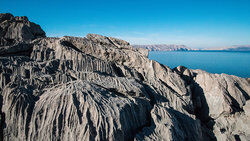3 Causes Of Chemical Weathering
5 Chemical Weathering Examples and How They Occur
Weathering is happening all around the world, all the time. When a chemical reaction is the cause, it'southward chosen chemic weathering. To find out how it happens and larn more fun chemical weathering facts, explore some famous examples of the phenomenon. And remember, chemic weathering doesn't happen alone! It has friends like concrete and biological weathering helping out, too.
 country with chemical weathering
country with chemical weathering
Chemical Weathering Facts
When information technology comes to chemical weathering, it's all nearly chemistry. By looking at the term "chemical weathering," you can see that a chemical reaction causes something to intermission down or "conditions." That "something" is rocks and minerals.
In chemic weathering, rocks and minerals are reacting to acids, oxygen, carbon and h2o. That's why no 2 rocks always look exactly the aforementioned. Information technology'south also the reason that nosotros have those awesome looking caves and unique rock formations all over the world.
While chemical weathering creates nifty formations, the way information technology breaks downwards rocks also causes fractures in ancient structures like the Great Sphinx of Egypt. It also causes the surface to intermission down on gravestones.
Types of Chemical Weathering
To truly empathise chemical weathering and how information technology works, yous need to look at examples of the unlike types of chemic weathering. Not all reactions that atomic number 82 to chemical weathering happen or work quite the aforementioned way.
Y'all also take to remember that chemical weathering types can piece of work separately, merely they often work together to create landforms and intermission down minerals. Bank check out how carbonation, oxidation, hydration, hydrolysis and acidification work.
Carbonation
When you call up of carbonation, think carbon! Carbonic acid is the culprit when information technology comes to the carbonation type of chemical weathering. As rain goes through the air and into the ground, information technology grabs carbon dioxide, creating carbonic acid. This weak acrid reacts with the calcium carbonate in stones when information technology seeps into the cracks.
A stone that is particularly susceptible to carbonation is limestone, which is made of mostly calcium carbonate. Carbonation of limestone creates unique structures like the Southward China Karst. Karsts are all over the world and include unique caves, streams, sinkholes and unusual rock formations.
Oxidation
Oxygen causes oxidation. You can think well-nigh oxidation similar rust on a car. Rust forms when the atomic number 26 or steel in your automobile reacts with the oxygen in the air to form iron oxide. The resulting cerise substance can be quite breakable, then much then that you could literally poke a hole in it with your finger. Rocks with iron can go through the aforementioned process, too.
Minerals with high iron content are affected by oxidation including pyroxene and amphibole. The oxidation gives these rocks a reddish look, very similar to the patina on a auto.
Hydration
This isn't the hydration used in your body, but it's similar. Hydration is a type of chemical weathering where h2o reacts chemically with the rock, modifying its chemic structure.
One example of mineral hydration is when HiiO (h2o) is added to CaSO4 (calcium sulfate) to create CaSO4+iiH2O (calcium sulfate dihydrate). It changes from anhydrite to gypsum.
The improver of the water to the anhydrite chemically reacts to create a totally new compound in gypsum. Hydration has led, in part, to the gypsum sand dunes at White Sands National Monument.
Hydrolysis
Water can add together to a material to brand a new material, or it can dissolve a textile to change information technology. In hydrolysis, the acid in the water works to deliquesce minerals within specific rocks.
Examples of hydrolysis in action include turning feldspar into clay and making sodium minerals into saltwater solutions. The flare slopes of Australia are partly created by hydrolysis.
Acidification
You've probably heard of acid rain. However, near people don't know what it is or how it contributes to chemical weathering. Acid rain is water with sulfuric and nitric acids from the burning of coal and fossil fuels, forth with volcano eruptions.
The acids create a reaction when they hit stone, causing the surface to article of clothing and the composition to soften. Acidification tin can also be acquired by organisms like lichens, which are created from algae and fungi.
1 well-known case of rapid weathering and blackening of stone is the weathering on the 1,000-year-former Leshan Giant Buddha in China. The 232-foot-alpine Buddha required six months of repair for weathering after only 12 years due, in office, to acidification.
Other Types of Weathering
Chemical weathering isn't the only type of weathering that affects the land. It has at least a couple of counterparts.
- Physical weathering is when rocks change without a chemical component, like landforms that are caused by natural Earth movements.
- Biological weathering occurs when rocks are weakened by plants and animals, similar when constitute roots abound through rocks.
Physical and biological weathering work in conjunction with chemical weathering to break down and erode land.
It'southward All Almost Weathering
Chemic weathering is when chemicals in rain and moving h2o react with rocks and minerals to modify or weaken them in some way. Chemical weathering always causes some type of chemic reaction within the rock or mineral itself. Expand your knowledge of the breaking downwards of rocks and soil through examples of erosion.
3 Causes Of Chemical Weathering,
Source: https://examples.yourdictionary.com/5-chemical-weathering-examples-and-how-they-occur.html
Posted by: alexanderdellittef1972.blogspot.com


0 Response to "3 Causes Of Chemical Weathering"
Post a Comment